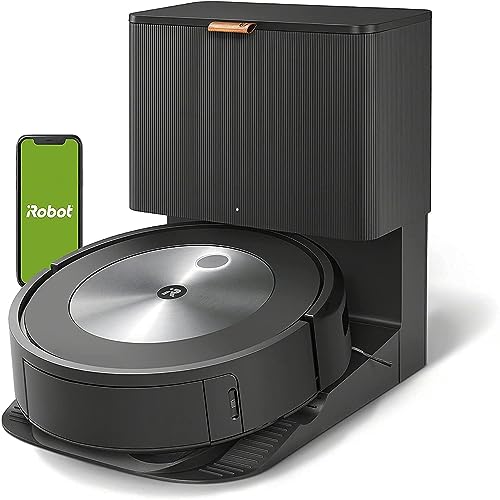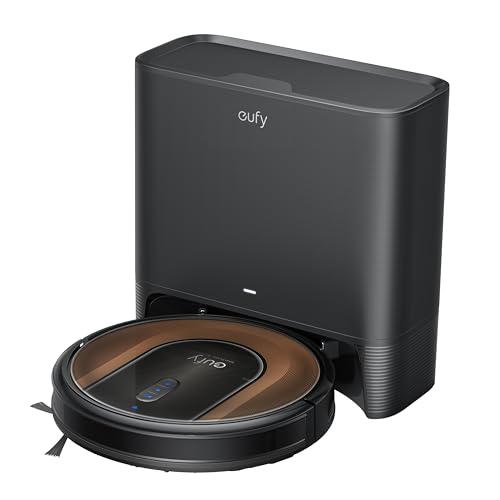You'll Never Guess This Self Emptying Robot Vacuum Mop's Secrets
페이지 정보

본문
 Self Emptying Robot Vacuum Mop
Self Emptying Robot Vacuum MopThe less hands-on you need to be with your robot vacuum or mop, the better. With a self-emptying robot you'll never need to worry about the problem of a full bin.
A robot that has an automatic base has a bigger water tank, and it can automatically wash and dry the mop pads. This fixes one of our most frequent complaints about other models.
What is a Self-Emptying Robot Vacuum?
A typical robot vacuum has an internal storage unit in which it collects dust and debris while cleaning. You may need to empty the bin every 2 or 3 cleaning cycles, based on the size of your home and the amount of dirt. Self-emptying robot vacuums take this task off your hands, by dumping debris directly into a larger dust bin on its docking station. The bin usually has a filter that collects and eliminates fine dust particles before they release into the air. This stops the bin from becoming clogged and full and causing the vacuum to smell or stop functioning properly.
The OMNI station prepares the robot for the next cleaning cycle. The OMNI station recharges the robot and cleans the brush roll. It also washes and refills mopping pads. It also empty the dust bin onboard and replaces its bag to ensure that it is ready for you next cleaning session.
This can be a huge time saver, particularly for busy households. It also reduces the risk that your robotic vacuum will accidentally release dust clumps in the air. This could be a problem for those with asthma or allergies.
The price of a robotic vacuum with a self-emptying feature is higher than those with no feature, but you'll save time and money. Also, you'll have fewer cleaning sessions, since you won't have to deal with a dirty dustbin in between uses.
One drawback of self-emptying robots is that it can be noisy during the emptying process. The noise can last for up to one minute and can be louder than the robot's own sound during cleaning. Some people might be frightened by the noise, however certain models come with DND modes and various settings that can help reduce it.
If you'd like to stay clear of this kind of noise, think about investing in a model that has an app integration that can be stopped. This allows you to control the robot with a smartphone or tablet. You can schedule cleaning sessions, set no-go zones and monitor the best robot vacuum self emptying's movements.
Self-Emptying Robot Vacuums Make sense in larger Homes
Robot vacuums do a great job of cleaning floors but they don't always get to those pesky corners and crevices. When they do run into obstacles, they can block the vacuum or cause it to roll over and break. The Samsung Jet Bot+, for instance features a fiber on its brushroll that can aid in keeping these obstacles away. It also has an intelligent power control that adjusts suction for different types of floors and a 5-stage HEPA filter that traps dust particles and allergens.
The Jet Bot+ is a ideal choice for homeowners who live in large homes that have a mixture of carpets and rugs, or empty floors. However the Jet Bot+ does not include a self-emptying function. There are other robot vacuums that offer a more powerful cleaning performance at a lower price.
The majority of self-emptying robot vacuums come with tiny dust bins that need to be empty manually after each cleaning cycle. This can be a bit annoying and is more so in larger homes where dust tends to build up fast.
Certain models have a dual-purpose dustbin, which can be used to store dirt as well as water to mop. However, you'll still have empty it manually after each use. These two-in-one dustbins also tend to have smaller capacities than the standalone versions, so you'll probably be filling them with water more often.
If you are looking for a robot vacuum mop that self-empty, pick one with a large cleaning capacity and low maintenance. This will help you save time and stress when emptying the robot, and give you more chances to utilize it for cleaning.
The iRobot Combo j7+ is easy to maintain and has a large storage capacity. The app lets you modify the settings for vacuuming and mopping. You can also create mopping zones and schedules. You can also replace the mopping pads if they get dirty, alter the flow of water during cleaning mode, and even create invisible walls to stop the robot from entering specific areas. The app can also be used to manage the robot's navigation and mapping functions, although it takes a bit longer than other models to finish the map.
Self-Emptying Robot Vacuums Make an Investment Worth Its Weight in Gold
While robot vacuums won't be able to be all-purpose or replace an upright stick, canister or canister however, they can save you time and prevent dust and dirt from accumulating in your home. Best bagless self emptying robot vacuum-emptying vacuums are very useful. They usually empty the debris into their docking stations and store it in a dust bag that only needs to be changed every 60 days or more. The fact that they don't bring the dust back into your home means that you'll have to deal with it less frequently and this can be beneficial for those in your household who are sensitive to respiratory allergies or other issues.
You'll also receive other convenient features when you purchase a self-emptying robotic vacuum cleaner that include automatic/set run time and mapping capabilities, mop/vacuum switching features, and smart home connectivity, which lets you control your robot vacuum with voice assistants such as Alexa. You might not require all of these features, but they add value.
The primary benefit of a robot vacuum that self-empties is that it makes cleaning much easier. If you live in a large house and regularly vacuum it, you shouldn't have to be concerned about emptying the dust bin every time you run. If you live in a smaller home It's still nice not be required to clean the dust bin after every vacuuming session.
Concerning the cleaning itself, the majority of self-emptying robot vacuums use a vacuuming process called "power suction" which generates a powerful current that pulls debris from the base and away from the floor. It is important to consider whether the vacuuming process will cause problem for your home.
Take a look at the DreameBot L20 Ultra if you're looking for an auto-emptying vacuum that can also mop. It can clean its mop pad and fill its water reservoir among other things. It might not come with the advanced AI-powered obstacle avoidance that some of the other vacuums listed here offer, but it's still a great choice for most households.
Self-Emptying Robot Vacuums Can Help You Avoid Dirty Dustbins
If you are looking for a robot cleaner you should look for models with dustbins that are automatically emptied when the robot returns to its original location. This will eliminate the burden of emptying a small dustbin several times during a cleaning session and ensures that your robot is always ready to go for the next round of cleaning. This feature is a must-have for busy homeowners, particularly those who live in large homes.
Self-emptying bases can reduce the time spent cleaning your robot's mopping pads in between cleaning sessions. This is a tedious task that can be frustrating however it is essential for the long-term health and longevity of your robot's pads. The positive side is that a majority of robot mops with self-emptying bases come with an automatic drying and washing feature that makes the process much simpler and quicker.
The most effective self-emptying robotic vacuums come with large dustbins that can store dirt and other debris for up to 60 days. This means you only have to empty them once every two months or more. This is a significant improvement over basic robot vacuums, which fill their bins with dust in a couple of weeks, forcing you to empty them far more often.
You might want to set up a schedule to have your robot sweep one area or room at one time, instead of sweeping your entire home. This will stop the robot from going into the same rooms over and over time, which isn't great for the long-term health of your furniture and floors.
Some models can even detect and avoid specific areas like pet bowls of water or spilled cereal by physically securing them off or enforcing them off using virtual boundaries in the robot's application. This feature is useful if you have pets or children who are prone spilling liquids.
While it's a nice feature, a self-emptying robot mop or vacuum isn't the essential feature for those who doesn't have a home that is particularly messy. The most important features of a robot vacuum are strong suction and a huge cleaning area that is able to pick up all the dirt, pet hair and dust from your floors.

- 이전글How To Explain Upvc Replacement Window Handles To Your Grandparents 24.08.04
- 다음글Five Killer Quora Answers On Large American Fridge Freezers 24.08.04
댓글목록
등록된 댓글이 없습니다.


